Banbhore
24°45′05″N 67°31′17″E / 24.7514°N 67.5213°E / 24.7514; 67.5213
| Part of a series on the |
| History of Karachi |
|---|
 |
| Prehistoric period |
|
| Ancient period |
|
| Classical period |
|
| Islamic period |
|
| Local dynasties |
|
| British period |
|
| Independent Pakistan |
|
|
Banbhore, Bambhore, Bhanbhore or Bhambhore (Sindhi: ڀنڀور; Urdu: بھنبھور) is a city dating to the 1st century BCE located in modern-day Sindh, Pakistan.[1][2] The city ruins lie on the N-5 National Highway, east of Karachi. It dates back to the Scytho-Parthian era[citation needed] and was later controlled by Muslims from the 8th to the 13th century, after which it was abandoned. Remains of one of the earliest known mosques in the region dating back to 727 AD are still preserved in the city.[3][4][5] In 2004, Department of Archaeology and Museums Pakistan submitted the site for UNESCO World Heritage Sites.[1]
Location

Bhanbhore is situated on the northern bank of Gharo creek, about 65 kilometres (40 mi) east of Karachi in the Thatta District of Sindh, Pakistan.[1] The city ruins are located on the N-5 National Highway between Dhabeji and Gharo.
History

The city of Bhanbhore dates from the 1st century BC to the 13th century AD.[1] Archaeological records reveal remnants of three distinct periods on the site: Scytho-Parthian (1st century BC to 2nd century AD)[citation needed], Buddhist (2nd century AD to 8th century AD), and early Islamic (8th century AD to 13th century AD).[2] The city was gradually deserted after the 13th century due to change in the course of the Indus.[5]
Some archaeologist and historians suggest that Bhanbhore is the historical city of Debal, which the Arab general Muhammad bin Qasim conquered in 711–712 after defeating Raja Dahir, the last Hindu ruler of Sindh.[2][5] However, this identification has not yet been confirmed, though numerous research and excavation works have been carried out to link the two cities. Preliminary excavations in the area were first done by Ramesh Chandra Majumdar in 1928 and later by Leslie Alcock in 1951. Pakistani archaeologist Dr F.A. Khan conducted extensive studies and excavations in the site from 1958 to 1965.[5] In March 2012, the Culture Department of Government of Sindh organised the first International Conference on Bhanbhore, where different experts and archaeologists presented their research on the site.[6]
Bhanbhore may also have been known as Barbari or Barbaricon (Βαρβαρικόν) to the Greeks and through the centuries, but it has not yet been proven that these historical cities are the same.[7]
Ruins
Archaeological findings show that the city consisted of an enclosed area surrounded by a stone and mud wall. The citadel was divided into eastern and western sections by a fortified stone wall in the center. The eastern part contains ruins of a mosque with an inscription dating to 727 AD, sixteen years after the conquest of Sindh, indicating the best-preserved example of the earliest mosques in the region.[1] The remains of the mosque were discovered in 1960. Remains of houses, streets, and other buildings have been found both within and outside the citadel.[2] Contemporary stone buildings from the three periods are also uncovered in the area including a palatial stone building with semi-circular shape, a temple, possibly from the Buddhist period or earlier, and a mosque. Three gateways to the citadel were also uncovered during excavations.[5]
Bhanbhore Port
Bhanbhore was a medieval port city deriving its wealth from imported ceramic and metal goods, an industrial sector, and trade. The city was strategically located at the mouth of the Indus, linking it with rest of the Indo-Scythians and Indo-Parthians and international traders in the Indian Ocean.[1] Archaeological findings show a half-submerged anchorage structure with solid stone foundation, which may have been used for berthing cargo boats.[5] However, the port was abandoned when the Indus river shifted its position and the creek was silted.[1]
World Heritage Site
The Port of Bhanbhore was submitted for induction in World Heritage Sites by the Department of Archaeology and Museums of Pakistan in January 2004. It is currently in the tentative list under the criteria iv, v, and vi of the cultural category.[1]
Gallery
-
 North wall of Bhanbhore Fort
North wall of Bhanbhore Fort -
 Banbhore Museum: excavated Shiva Linga
Banbhore Museum: excavated Shiva Linga -
 An old well in Bhanbhore Fort
An old well in Bhanbhore Fort -
 South Gate of Bhanbore Fort, where the Muhammad bin Qasim entered the Fort
South Gate of Bhanbore Fort, where the Muhammad bin Qasim entered the Fort -
 Banbhore Museum: seize of Bhanbore Fort by Muhammad bin Qasim
Banbhore Museum: seize of Bhanbore Fort by Muhammad bin Qasim -
 Floor of the Bhanbhore Mosque, dating back 727 AD
Floor of the Bhanbhore Mosque, dating back 727 AD -
 South wall of Bhanbhore Fort
South wall of Bhanbhore Fort -
 Tower of North wall
Tower of North wall
See also
References
- ^ a b c d e f g h "Port of Banbhore". World Heritage Sites, Tentative List. UNESCO. Retrieved 3 September 2012.
- ^ a b c d "Banbhore". Dictionary of Islamic Architecture (PDF). ArchNet. Retrieved 3 June 2019.
- ^ Kit W. Wesler (19 April 2012). An Archaeology of Religion. University Press of America. p. 253. ISBN 978-0761858454. Retrieved 8 September 2012.
- ^ "Friday Mosque of Banbhore". ArchNet. Retrieved 8 September 2012.
... the Jami' Masjid of Banbhore is one of the earliest known mosques in the Indo-Pakistan subcontinent.
- ^ a b c d e f "Banbhore Museum". Culture Department. Govt. of Sindh. Archived from the original on 8 November 2012. Retrieved 3 September 2012.
- ^ "International conference: Experts question if Bhambhore is the historical city of Debal". The Express Tribune. 12 March 2012. Retrieved 3 September 2012.
- ^ Panhwar (Summer 1981). "International Trade of Sindh from its Port Barbarico (Banbhore), 200 BC TO 200 AD" (PDF). Journal Sindhological Studies. pp. 8–35. Archived from the original (PDF) on 4 July 2017. Retrieved 4 September 2012.
Further reading
- F. A. Khan, Banbhore; a preliminary report on the recent archaeological excavations at Banbhore, Dept. of Archaeology and Museums, Govt. of Pakistan, 1963.
- Sintubin, M. (2010), Ancient Earthquakes, Geological Society of America, pp. 123–124, ISBN 978-0-8137-2471-3
- Wink, André (1996) [first published 1990], Al-Hind: The Making of the Indo-Islamic World, Vol 1: Early Medieval India and the Expansion of Islam (Third ed.), Brill, pp. 181–183, ISBN 0391041738
External links

- Sama Faruqi, Resolving the mystery of an ancient site in Sindh Dawn (Herald magazine), Published 23 September 2016.


















